Don't wanna be here? Send us removal request.
Text
213729 Fine Arts Research & Development: Honors ⋆ SUMMATIVE

Tumblr has a strange layout, so when reading:
Be sure to scroll almost all the way to the bottom, until you reach Week 1.
From there, read down, then scroll back up to Week 2, then read down again. Enjoy!
0 notes
Text
213729 Fine Arts Research & Development: Honors ⋆ WEEK 13
The evening before presentation, I cleaned up my space, swept the floor, and flattened out any loose tape. I don't view the Amorphous Shame as specific, let alone relational to any space - for it exists within itself - and so it stayed.



Come presentation day, I still had all my cables in studio - and I also hadn't actually tested the tech yet. But when I did, it worked just as fine as before - not modifying the sampling side of things had freed me up to work on the sculpture, and it'd paid off.



The setup was straightforward - I hadn't even sketched it. The sculpture was built around a chair, so placing the computer underneath a studio chair and sitting atop worked smoothly. From there, three volunteers lowered the chassis on top of me, where I could then discover that the fucking thing had stopped working.



Following a brief technical hiccup at the 11th hour, I wrangled up some students left behind during the Tuesday hand-ins to lower the 'lump' onto me while my rōpū was out. This is what they saw when they came back.

I was in there for about 15-20 minutes before they arrived, much longer than I was comfortable with. I'd spent longer in there before, but with a chair set up, I could barely move my arms, and the computer beneath me heated up the air.
To avoid panicking, I'd record static into the speaker, and close my eyes, focusing on breathing and imagining myself elsewhere, resting my head against the opening with my mouth tilted upwards.



I got inside the sculpture a second time later that day to demonstrate to a group of friends, during which I screamed into the microphone, which made the speaker distort my voice to a very loud hiss.
The video below compiles footage from my classmates from both showcases, in the latter of which you can see my genuine discomfort.
But it was a discomfort shared. The eyes within eyes, taped-up lumps and especially the teeth were off-putting to viewers, all drowning in repetitive noise as any attempts of my communication were quickly swallowed by my resampled voice.



I wished I could show it off like that for longer, but I need my computer for writing this, unfortunately. And so the 'Amorphous Shame' has been removed, its husk sitting alone as the Shame walks freely again.



I'll probably invest in an oxygen mask next time.
1 note
·
View note
Text
213729 Fine Arts Research & Development: Honors ⋆ WEEK 12

Dillon, Diane, and Leo Dillon. [Front Cover Illustration for I Have No Mouth and I Must Scream.] Painting, 1966.
It was down to the wire by this point, and coupled with three night shifts over the weekend, meant I had little time to work on the sculpture during the day.
Instead, I used the sculpture to my advantage, and would end my shift half an hour early at 10:30pm, rush over, then hide inside the sculpture until the security had gone.
From there, I'd work in the pitch black until the early hours of the morning. If not for this, I would not have finished on time.

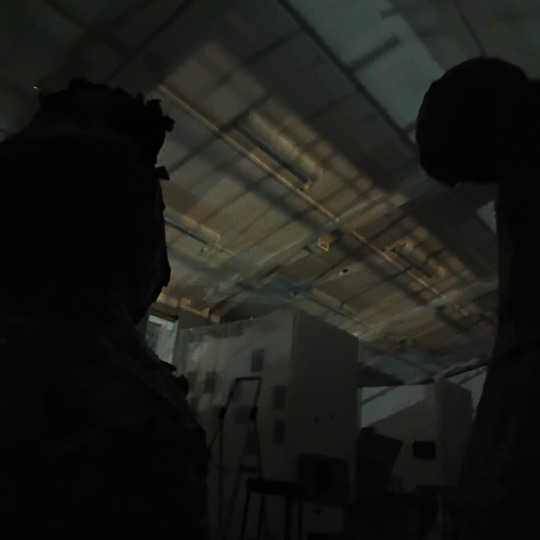
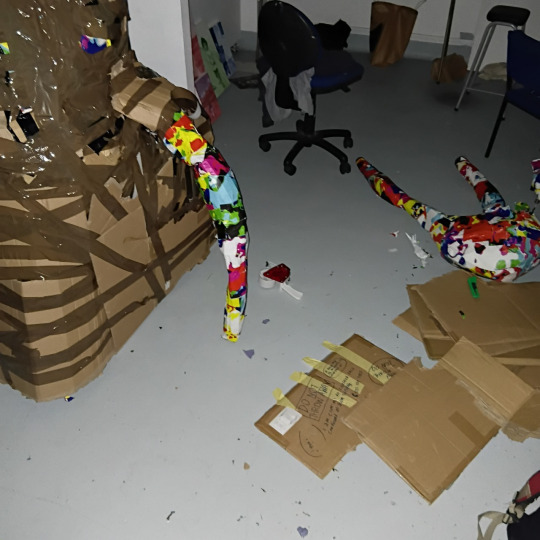
Perhaps borrowing from Hirschhorn's 'deposits', or grotesque cybernetic forms from media and mutation, I let imagination guide me during my process, as limbs, lumps and creases erupted across my work. Just as before, I'd flip the piece, affectionately titled 'lump' on it's side, strengthening the innards and sculpting out holes.



I'd then tape upon tape, squeeze parts while stretching others, and leave cups, tape rolls and mugs inside open holes overnight to dilate them for further sculpturing the next day.



I found the piece to be a little more structurally fragile than my previous, and still needed plenty of tape to hold it (and me inside) together.



To avoid material monotony however, I didn't cover any exposed cardboard without a good reason to. If the cardboard was sticking out, so be it.
For the mouth, I needed to hide the speaker from outside view, so I printed out a mouth to stick over it, leading to a terrifying result.


0 notes
Text
213729 Fine Arts Research & Development: Honors ⋆ WEEK 11
As I developed my new sculptural performance, I named it the Amorphous Shame; and this deserves an explanation, although it's a bit of a mouthful.



The Mystery Flesh Pit National Park is an online work of satiric fiction. It imagines a deep, mostly unexplored ancient superorganism residing in an earth basin, resembling a giant pit of flesh... which has been turned into a national park, complete with guided tours and merchandise. Upon this concept, the community contributes fake pamphlets, scientific reports and speculative biology designs.
One such design is of the Amorphous Shame, a writhing clump of organs, DNA traced to be a descendant of the weasel. Due to the orfices in the flesh pit being lined with nutrients, the Amorphous Shame atrophied, its environment forming the body that it lacks.
The fictional diagram below by artist Trevor Roberts humorously entails the evolution process.

For me, the Amorphous Shame is shriveled and hideous, atrophied by its environment into a decadent nothingness; to me a cautionary tale of a more personal shame, had I let a social expectation of normalcy define my outside, as my true self cushions into gelatin within.
By sitting inside my sculpture, I shift the moving parts from 'I beg your pardon' to redefine its meaning. The cardboard embodies/encases - me, the inner self now malleable and helpless against the distortion between itself and the outer world, a familiar childhood sensation of being aware of my social disabilities, yet unable to actively convey normality in escape of it.
In a talk with Eugene, we discussed what it means to exist in the sculpture, within an 'electronic network of senses and outputs'. He called it almost 'cybernetic', evoking works such as the likes of Stelarc's Ping Body (1996).
During his performance, internet users were able to send pings (data values) to muscle receptors on Stelarc's body, causing involuntary movement.
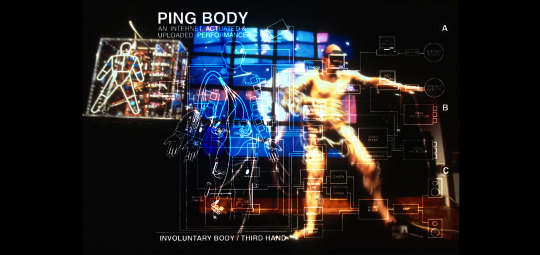
I was reminded, from this, of the Tetsuo: The Iron Man - a 1989 Japanese posthuman horror film spiralling on a fusion between man and metal. While handled with an air of eroticism, The Iron Man embodies a working population dulled and misshaped by the modern office lifestyle.

A similar 'engulfing' by the cybernetic is with Atsuko Tanaka's Electric Dress (1956). An electrician had wired up a drapery of incandescent bulbs upon her body - known for getting very hot - to which in anticipation for the dress being turned on, Tanaka compared to that of a death row inmate.
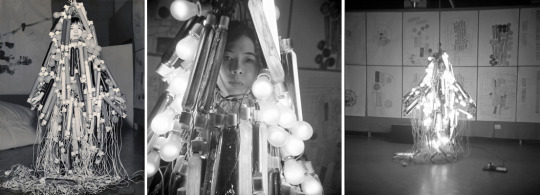
My making process had also drawn connections to Erwin Wurm's One Minute Sculptures (1996-present) which utilize spontaneous misuse of object in relation or absence of human form, creating a new sculptural form.

As I constructed the head, I considered how audiences had reacted to my piece while exhibiting at Solander. Since the people coming in had no prior context to my work, let alone art school mannerisms, I noted the general apprehensiveness to interact with the piece.
People would stand in front of the work, taking it all in, and after staring at the symbols, would either ask whoever was gallery sitting if they could touch it - or would not touch it at all.
I was still not keen on having any text, but I knew there had to be a simpler, more effective way to entice the action of speaking. Leaning into the sci-fi, mutative sculpture angle of Eugene and I's conversation, I figured that having an anatomical basis for interaction - an ear to speak to, a mouth to speak from, an eye to see - would indicate, through human predisposition, the interactive function of the piece.

I cut out an ear, drilling a hole to the inside, then attached smaller cardboard shapes and scrunched up tape to mold it as I pleased.



Very little was put to waste. Legs from the BRAZEN FUCK OBJECTS were sawn off and reattached to stabilize the structure. A discarded tape roll formed the eye, while scraps from the ear went into forming the mouth.



I'd gotten quite comfortable with the sculpting process by this point - if I had an idea of how it'd look in my head, I could pretty reliably recreate it in a couple hours of vigorous taping.



I would frequently go into the sculpture to work from the inside, as well as to keep it fitting my form.



0 notes
Text
213729 Fine Arts Research & Development: Honors ⋆ WEEK 10
To avoid insanity, I've kept some side-projects on my radar, particularly through Staffroom. One such project in the works is a sample-based mixtape titled "Web 2.0", which is modelled retroactively on the mid-late 2000s rekindling of online optimism, sampled entirely from the corporate, copyright-free music found in YouTube keynotes, talks and presentations on this 'emerging' web landscape.
It's a creative breath of fresh air, and another facet of my audio art.
After my exhibition, I was stumped as to where to go from here.
I at first considered just adding to my preexisting work, making it portable, more high-tech somehow. Or perhaps creating a smaller, doll-like version; a 'tickle-me-elmo' sample piece... but I was feeling uninspired with having to rethink my entire sampling process from scratch.
Cassie Freeth, cardboard-horror-extraordinaire, conversed with me that after going big with her cardboard house, she hit a limit with what to do, choosing instead to sculpt upon herself, and bring performance to the sculpture.

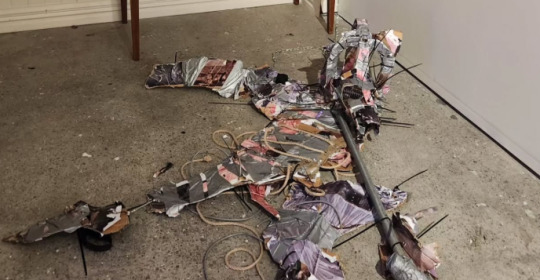
So I started wrapping cardboard around a chair as I had before, but as the tower grew, I kept the chair in.



This was because I was going to be inside the sculpture.

The softer cardboard from my older BRAZEN FUCK OBJECT sculptures came in handy for the destructive design process, as I cut out pieces and morphed on others to allow me to sit comfortably inside.
This would mean the piece would be shorter, but with my legs needing to fit somewhere, it quickly made up for it in other ways.



0 notes
Text
213729 Fine Arts Research & Development: Honors ⋆ WEEK 9
We got a brief taste of workshop class with an induction to the Block 1 music facilities. This session included field recording, a tour of the recording studios, along with a step-by-step guide to using Logic software.


Back on the studio front, I got to wrapping my sculpture, circling round and round with the tape gun until I'd covered every piece of exposed cardboard.




Adding symbols to the keyboard was as simple as painting it on, and I attached a tape fixture to it, to fit inside a small incision above the mic. Once in, I could tape over any wiring, and it'd blend right in!



Leaving the minutia for install day, the piece was ready for transporting to Solander gallery; so we hired out a Cityhop, which promptly needed roadside assistance as the battery broke down.


The next day at Solander, I readied up the instruction symbol, and wired up the insides. As this was also the first time I'd tried doing this, I had to make a round trip to Jaycar to get all the USB extension cables I'd need.
I cut out a sizeable hole at the base so I could slide my laptop in, making it large enough for me to operate. There wasn't enough space to fit the mixer in, however I'd argue a mixer looks pretty cool regardless.



With that all sorted, my two month project - 'I beg your pardon' - was complete, and was showcased in the Disclosure exhibition from the 6th to 11th of May.
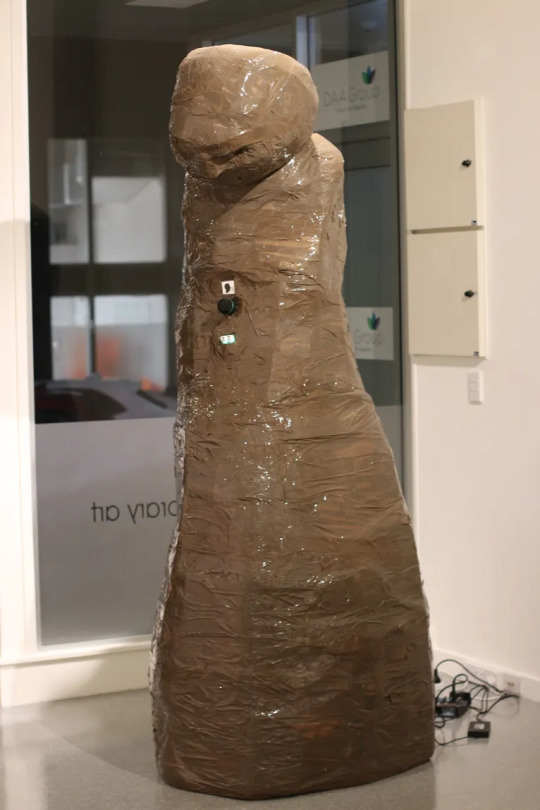

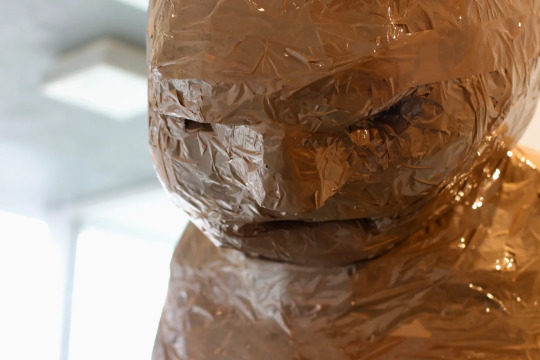


This video shows a demonstration of the sample slicing system in action:
0 notes
Text
213729 Fine Arts Research & Development: Honors ⋆ WEEK 8
While I was hanging out at my mum's friends house, I picked up a copy of the Life Science Library book The Mind (1964) and took photos of the various symbols within; which I turned into animations for a music video back in February.



I got to rekindle this while working on my sculpture, as with previous showcases needing me to prompt the audience into interacting, I had to find some way to explain and encourage a viewer to speak to my work, without breaking any immersive consistency.


I thereby designed two symbols for each of the keys - one to record, and one to 'undo'. I also drew up a speaking face as a single-image 'tutorial' of sorts.

With development centering on a single piece for so long, the way I described my work developed too. For my exhibition course presentation on March 17, I described it as the following:
"My project that I’ll bring to this exhibition seeks to immerse the audience, through interactive sound-sculpture, into a personal frame of mind as an autistic artist, with works embodying the experience of growing up neurodiverse. Experimental sampling, towering cardboard monoliths and human coldness bring an unsettling, yet deeply introspective atmosphere; that places the viewer behind the wheel, placating - if just for a moment - an understanding of a life through neurodiverse eyes, where words otherwise fail."
And on May 4, for our exhibition pamphlet, I described it as below:
"Title: “I beg your pardon” "Cardboard, tape, laptop, Max 9, bluetooth speaker, keyboard, microphone, mixer, audio jacks, paper scraps. "My piece presented in Disclosure is an interactive audio sculpture that you communicate to, and are miscommunicated by. "The form, size, and mechanisms of this piece forces the individual into a disconcerting position as they interact. Here I seek to reproduce, through immersion, the social struggles that came with growing up autistic. "To talk was a balancing act of composure, feigning understanding yet trying to be understood. There was a personal helplessness; in recognising myself and being aware of my social shortcomings, and yet still finding a barrier within everyday interactions. I hope this work can allow a neurotypical audience to understand these experiences like I did, and for a neurodiverse audience to find solace in its familiarity."
I should take a moment to acknowledge that while not intentional, there is a visual resemblance between my piece and the Parihaka prisoners memorial.

Being near my piece, I would constantly hear the crackling of tape gradually coming loose. I'd in turn, flip the piece on its side and strengthen the base and insides, the latter requiring me to go inside my piece.


I was now reaching the exciting point where I could make room for the audio gear that would sit within the cardboard, and I mapped out some incisions for the microphone and cabling.



0 notes
Text
213729 Fine Arts Research & Development: Honors ⋆ STUDY BREAK
I was proud of the work I'd made last year, however received critique on how I spent most of my time researching to assemble my piece in the final week. This year, I've aimed to develop my work from day one- embodying my research through the making process.
Using the crumpled, more malleable cardboard from my BRAZEN FUCK OBJECTS, I created a sturdy neck for the head to sit upon, as well as a pocket to fit the speaker.



I later repurposed this to be a hunch, realizing I could better fit the speaker within the head. I mainly worked on organizing the exhibition over the break, but the form was now finalized.

My classmates and I attended the opening night for We know what art is : It’s paintings of horses! at Meanwhile gallery. I saw a lot of visual parallels in the cardboard and paper mache sculptures on display, as well as being able to talk to Fahsai, another audiosculptural artist who was exhibiting there.



Last year, Fahsai made an audio sculptural series titled This Being I Must Create, one variety of which utilized electronic receptors, a computer audio setup, and fluid bags of seaweed to create a living sculpture. At the opening night, I let her know of the inspiration I'd gotten from her work.

▶ https://exposure2024.massey.ac.nz/students/fine-arts/fahsai-chainarong
0 notes
Text
213729 Fine Arts Research & Development: Honors ⋆ WEEK 7
For critique, I cautiously balanced the head upon my cardboard pillar, fit the bluetooth speaker inside, and had the audio setup nonchalantly placed on an adjacent table. Being a work in progress, I had to tell each interacting viewer how to record using the keyboard an mic, but I was happy with the response overall.
I think I finally came up with a name for my piece: "I beg your pardon"

I chose this phrase (notably without a question mark at the end) after a lengthy process of trying to encapsulate the communication process between the audience and the sculpture, while not giving it away. Having a cheeky nod to the confusing phrases that erupt from the piece, alongside being a sentence I was told a lot growing up.


CRITIQUE TIME, BABY.
Outline the 5 main discussion points raised during your formative critique:
The foremost discussion point from my critique was shown not through conversation, but from audience action - particularly the lack thereof. Despite me defining from the start that the audience was welcome to come up and talk to the microphone, few did; and after two students (plus lecturer Israel) gave it a go, no one else budged, even after I encouraged them to.
It was terrifying! Quite a few in the rōpū found the experience of hearing their own voice being mangled and projected from a looming, cardboard body to be uncanny.
It was... exciting too? The sampler in my work records onto a 10-second-long track, and as most people only recorded a second or so of their voice, the resulting sound would be silence interrupted by random snippets of voice, which led to an amusing collective anticipation for when the next sound would play.
Clear themes of communication / miscommunication. People noted how, with the speaker inside the sculpture, it seemed as if the form were repressing something.
The size and form of the piece seemed monolithic, perhaps even monumental - and yet some viewers personalized the sculpture, even calling it 'cute'!
I recalled hearing of the audience response to the 'companion cube' object in the 2007 puzzle videogame Portal being one of pareidolic affection, as the cold, clinical environments left players attached to anything remotely resembling love in its environment.

Where to from here?
The trajectory from here is to smoothen out the interaction between viewer and art. People will be less shy towards the piece when talking to the piece on their own (as opposed to in front of 20+ silent classmates), and the work should be easy to understand, and encouraging towards interaction. A simplified presentation, with two buttons and a microphone shown to the audience, along with some minimal labelling, should do the trick.
I also plan to place all the gear the piece runs on- inside the piece itself. This poses its own challenges of structural integrity, managing the limited space, and even keeping the machinery cool.
Hence, I also plan to have a large access hatch out of view in the rear of the piece, which can be used to turn the equipment on/off, along with doubling as ventilation.
I should mention by now, the clear visual link between my work and of the 'deposit' sculptures of Thomas Hirschhorn, and this is no accident. Bulbous growths erupt from suspended object forms, their nature wrapped in tape. I cited Thomas Hirschhorn's works back in 2023, taking inspiration for the BRAZEN FUCK OBJECT in its wrapped, tumorous presence.

Hirschhorn, Thomas. Candleholder with mannequin busts. Sculpture, 2006.
The visual paralells to Hirschhorn's respective Candleholder [...], Candelabra [...] and Chandelier [...] sculptures are evident in the body usage of brown packaging tape, but the linkage goes deeper. The Museum of Modern Art in Warsaw details the following about Hirschhorn's Chandelier avec bustes de mannequins:
"The forging of attitudes and hiding out in the trenches of one’s own ideological positions creates, in effect, knots and tangles – like deposits or tumours on the social body. The deposit is symbolised by the tape-bound mannequins who create this peculiar chandelier which sheds no light and emanates no warmth."

(Egenhofer 121)


From left: Hirschhorn, Thomas. Candelabra with hands. Sculpture, 2006. Hirschhorn, Thomas. Chandelier with heads. Sculpture, 2006.
Hirschhorn, Thomas, et al., editors. Thomas Hirschhorn: Establishing a Critical Corpus ; [Claire Bishop, Sebastian Egenhofer, Hal Foster... Published on the Occasion of ‘Crystal of Resistance’, the Work by Thomas Hirschhorn at the Swiss Pavilion on the Occasion of the 54th International Art Exhibition of the Venice Biennale, June 4 - November 27, 2011]. JRP Ringier, 2011.
Halfway through the week, my 2-key controller arrived, and I got to work with testing it out.

I updated the sample-slicing patcher to be mapped to the keys accordingly; and after some technical hiccups lasting a good 20 minutes, it worked a treat!
I'm planning to label both buttons, with a plaque above stating "press and hold as you talk".
Due to the small size, I'll stick on some cardboard on the back of the keyboard, which I can then tape to the rest of the structure from the inside, including covering the USB connection from the outer view.
0 notes
Text
213729 Fine Arts Research & Development: Honors ⋆ WEEK 6
I'm fascinated with post-human music. Post-humanism is the decentralization of humans from the equation, shifting the focus away from us. In sound, I like to use the phrase 'Auto Audio Art' to describe it, and have even considered making some 'A.A.A' myself for this semester's studies, which you can see on my holiday sketch page:
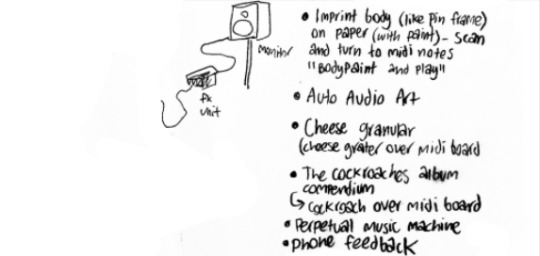
After learning (from Mike Bridgman, no less) of the existence of metallic paint that could transmit midi signals on contact, I got ideas. One such concept was cheese granular, a malaphor of 'cheese grater' and 'granular synthesis', which involved me grating cheese over a MIDI-painted table, with notes playing based on wherever the cheese lands.
I took some notes during our impromptu talk:
keyboard main board / controller instead of midi multi output keyboard
"it's not easy"
Arduino might be a way for just a couple of switches, it might be a tutorial away
talk to workshops top of block 1 has an electronics workshop not sure who controls that, talk to technicians
talk to Mike Bridgman for possible hiring out a mac mini could possibly be lent mac (same form factor as mac mini but pc)
mike has mic go figure and perchance a better set of speakers/ monitors speaker stand
tested the speaker and mixer setup tried by routing it to my laptop speaker instead of monitor and also into the mixer with not output dawg I think the speaker is the problem
"it was in the trash for a reason"
IF NO SPEAKER MATCHES FORM FACTOR buy cheap t-amp (a digital class amplifier) that offer twelve volt power supply for building a speaker also you can hook it to a passive speaker designed for battery packs/low power setups/high response speakers Eugene has plenty for lending
not difficult to build speaker into the sculpture with t amp and speaker
he also has speakers with a stand and even a non broken version of my speaker! Except the stand might not even go to 2 metres, let alone 3
He has a bluetooth speaker, which is lighter and can be 'cradled' by the head, i'll have to check if my laptop outputs it
Giant midi pedal: button You can open up a big midi button and replace the switch
Footswitch with multiple buttons and put where hand is Philips blutooth

The other day, my mum sent me a letter.

Inside, she'd attached a New Yorker article about sound artist William Basinski, the composer behind the Disintegration Loops; which I've thrown in as a little extra source.


With Eugene and Mike's advice in mind, I got to searching for a good two-button setup for my sculpture. Finding a decently-priced MIDI pedal was easier said than done however - and while I could just buy two cheap keyboard pedals, the cost, along with the hassle of returning it if it didn't work, put me off it.
So I looked for a two-key keyboard instead, and yeah, that was quick.

Thanks to the popular rhythm video game OSU, two-key keyboards are a surprisingly common find on the online market! Who knew that people not going outside could contribute to society this much?
And now for some fine literature.

When it comes to books about sampling in the Massey Library database, no other fit the search quite like Eduardo Navas' Remix Theory. I borrowed myself a copy a few weeks back, but only really sat down with it 'now' - a term I use loosely.
Remix Theory is first and foremost, dedicated to the remix - the sample is discussed, no doubt - although what Navas defines as 'Remix' goes far beyond the limits of music. This is accompanied by a plethora of graphs and diagrams - ripped straight from Navas' own remixtheory.net website.
I find a lot of these graphs to come across as rather anecdotal, as they define specific stages of 'mechanical reproduction' [m.r.] and 'remix' over the past 200 years through a lens either too broad [photomontage as a whole being a 'stage of m.r./sampling], (Navas 18) or too specific [dub culture onwards being the 'first stage in remix'] (Navas 21).
To understand the 'Remix' as Navas does is to reassess your perception of reality, with the 'Remix' being the unifying glue to existing:
A playlist on your phone is a remix. (Navas 27)
A photograph is, due to the framing and visual reproduction of a specific window of something that is now ontologically different than it was when the photo was taken, a remix.
You are a remix of your parents.
Matter cannot be created or destroyed, it just gets remixed.
Now that were on the same logical-endpoint-waveform, it's pretty easy to see how the work I'm making is quite holistically a Remix.

The interacting audience is placed in an active role of remixing themselves, or alternatively, enact my computer to remix for them. Beyond this, my choice of recycled cardboard for constructing garners a new meaning, as I've now remixed cardboard from various different locations/purposes to be used and re-defined in a single sculpture.
So how is sampling defined in Remix Theory?
"...the principle of sampling at its most basic level had been at play as a cultural activity well before its common use in music during the 1970s." (Navas 11) "Early recording, in essence, is a form of sampling from the world that may not appear as such to those used to the conventional terms in which the concepts of recording and sampling are understood." "...sampling favors fragmentation over the whole." "Recording is a form of sampling because it derives from the concept of cutting a piece from a bigger whole."
The namesake of the current exhibition at Adam Art Gallery, Things are, they do not happen, is attributed in the associated pamphlet to Mexican poet Octavio Paz. "He is referring to the way a painting is unable to reveal the action of its making, or the unfolding of time outside of its frame."(Clifford 1)
"At the time of this writing, sampling is [understood as] copying in material form [...] from a pre-existing recording. This principle of sampling, which became popular in the 1970s with DJ producers of disco and eventually hip-hop, is a meta-activity that follows early forms of sound capturing. Early sound recordings, with a similar approach as photography's, were also tools used to copy (sample) from the world." "In current times the latter becomes a default state with the computer: to sample means to copy/cut & paste. Most importantly, this action is the same for image, sound and text. In this sense, the computer is a sampling machine: from a wide cultural point of view, the ultimate remixing tool." (Navas 14-15)
"Music sampling was a transitional period toward privileging the fragment over the whole; and it is no accident that sampling in music became popular during the postmodern period. [...] While it was the medium of photography that came to define our relationship of the world through recorded (sampled) representations, this tendency would take its first major shift towards what is known today as modularity [...] in the explorations of composers, like Stockhausen, who with tape loops aesthetically alluded to what the computer actually does today. Tape loops run repeatedly until they are turned off, or fall apart from wear and tear; similarly, computers check themselves in loops in fractions of seconds to decide what to do at all times. Looping, or modular repetition is what defines media culture..." (Navas 30-31)
Thanks, mum. Turns out the source on William Basinski's tape loops you sent me had more connection to my research than I'd ever predicted.
Navas, Eduardo. Remix Theory: The Aesthetics of Sampling. Austria, Ambra Verlag, 2012.
Clifford, Jess. Things Are, They Do Not Happen. 2025. Te Pātaka Toi Adam Art Gallery, 2025.

It was now onto the body. I began by wrapping cardboard around a chair, then taped cardboard in a tesselating pattern gradually upwards. Following our chat, Mike had gifted me a Bluetooth speaker [editors note, the speaker had been removed from my space by Week 8, and was replaced with Em's smaller Bluetooth speaker] and I tested it out.



I entered a sort of zen with my making process, and this was facilitated greatly by my tape gun.



It didn't matter if it got crooked - I would keep it as such, strengthen the frame, then keep building up...



...and up.... and up...


...to the point where you could sit inside it, as demonstrated by Ana!

0 notes
Text
213729 Fine Arts Research & Development: Honors ⋆ WEEK 5
I hauled over all the audio gear I'd need for a live tech demo on Wednesday.
My laptop was running max, and connected by USB and headphone jack to my Wharfdale 802 mixer. I brought over that mic I had sitting around and plugged it into one of the six mixer ports, and connected the mixer output into the speaker.
For reference, it looked it this.

If you couldn't tell, it wasn't working.
Computers are remarkably versatile for processing sound, as you can quickly sort between which audio it chooses to take in - and output. However, no sound was coming out the speaker, let alone being registered on the mixer!
I wandered around campus for an hour until I found Mike, who popped over for a test.
The madman - he got it working! Turns out that ALL the audio had to pass to and from my computer via the USB - and that the volume needed to be shoved WAYYYY up.
But after Mike left, I was facing a new issue. Every time I recorded with the mic, the 2 second sample got louder, and louder! To the point where just whispering would nearly erupt the speakers.


I volunteer every Tuesday afternoon at Adam Art Gallery. On the 24th of March, I was invited to a volunteers-only talk between gallery administrator Ann Gale and director Abby Cunnae.
This proved a very valuable meeting to attend, being a discussion on the ins and outs of curation, which I noted on two pages.
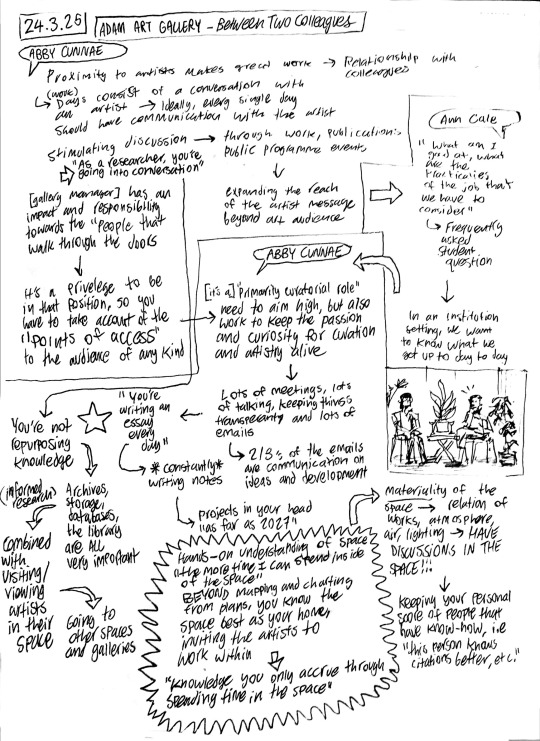

Back in studio, I tested out what essentially was a loud static generator. Low and behold, finding a free discarded speaker doesn't come without some tradeoffs.
I continued sculpting my 'Übermensch' (as my mum put it), boring holes to form eyes and a mouth.



From there, I fit the speaker inside, leaving some leeway to operate the volume.



And voila, my first tech demonstration, ready as a work in progress for critique.


CRITIQUE TIME, BABY.
I started off by demonstrating the piece. With the presentation not clearly labelled, I had to prompt my classmates as to where to go and what to do. Out of the 7 minute critique, this took 2 minutes.
It was a bit of a mouthful to give a disclaimer on how loud the piece could get, along with instructing the button presses: aspects of the piece that I'd be making more intuitive and user friendly with time, I mainly just wanted to show off the tech involved.
When people started speaking into the mic (prompted), most just made unintelligible sounds as opposed to speaking.
If I want people to talk to the work in the future, adding a "push to talk" label to the microphone would subtly push people to have conversations with the piece.
"I like how its not a clear thing [...] like, it's communicating to us [unintelligible]"
"So it just cuts parts of [unintelligible]"
"It's quite jumpy..."
"I feel like that kind of reads as miscommunication [...] this idea of what you're trying to say ends up coming out... wrong. It's not clear [...] what they say isn't quite what you get-" "-and it gets repeated" "Yeah, it's like a cycle of distortion-" Kaylee honks their clown nose several times.
"I like the collage-ness of it, like how it reflects the audio..."
"So it's gonna have the tape and cardboard, like you can see the materials?"
"I like how he has a mouth, and the speaker's inside it. [...] The head's talking, but it's not making much sense, you don't know what he's trying to say."
"He looks like he's in agony lowkey, like he does not look happy..."
"It's like he's trying to say something"
"This is really interesting to me, because I have misophonia, and this is how I experience loud rooms [...] I'm always getting clips of stuff. But it's super clear clips, but I can't hear it clearly if someone's trying to converse with me, so I'm [viewing this piece] like, 'ugh, this is my brain' [laughter]"
"Yeah, kind of like that auditory processing, someone's talking and you're like 'what are you saying', or being overstimulated [where] there's a lot going on."
I explained my plans for where I'd be developing the work next.
"It's like, this is you, this is what you're trying to say, and what you say just comes out wrong. It's this idea of being misunderstood, like 'I didn't mean to say that, I was meant to say this', but that's what comes out.
At this time, I noticed a big pile of cardboard at work, which I reached out about using. After being approved, I visited after hours and bundled up the lot, and balanced it on the scooter all the way back to campus.



0 notes
Text
213729 Fine Arts Research & Development: Honors ⋆ WEEK 4
I didn't go into Max with any plans for a test project - I had my sampler idea, and I was going to make it right away.
This would involve meshing several different tutorials from YouTube, beginning with a "sample slicer" tutorial, which I followed to a 't', noting down useful observations I made along the way.
Andrew Robinson ▶ "Sample Slicer Tutorial - Max MSP Tutorial" https://youtu.be/E0bTX5frBbI
Creating an 'object' makes a text box, which you type in your desired element into to garner it.
To observe the effects of the box (in this case, a buffer ~ sample), I have to press Ctrl + double click.
I then added a 'message', "replace", which I connected to the object.
Dragging my sample in, in this case, a recording of Super Mario, places it within the observation tab.
As to not lose my head, I balanced the software with the hardware, and kept rounding out the head. Flamingo scooters were my primary transportation for getting street cardboard over to studio, which I would tuck between my legs like a penguin.



I quickly swapped to cheaper, brown packaging tape, which was $5 for three rolls as opposed to $7 for one roll of scotch, and came with a tape gun, which freed up an enormous amount of time.



You could also wear the head like a mask!

This was some good distraction, especially since I was struggling to get the Max MSP tutorials to work for me...
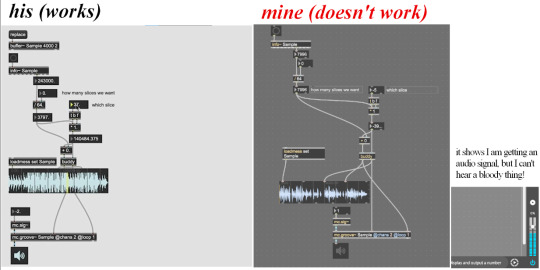
Silly me, turns out I just hadn't set my audio output yet!
With it now working, I could have a bit of fun sliding the numbers around and chopping the sample manually.
But my work was not done. The slicer was complete, but now I needed it to slice and play back automatically, and for new sounds to constantly be recorded in by a mic.
The idea is that a person records their voice, it gets garbled back to them for a defined amount of time, then the recording can be over-dubbed/replaced by someone else's recording.
This would involve using a buffer, which briefly stores a sample into Max's memory.
I then assembled a mic and speaker according to this tutorial:
dearjohnreed ▶ "Max 8 Tutorial # 19: Recording and Playing from Buffers" https://youtu.be/n1H2lN4FSN4
Hearing Glass | Umut Eldem ▶ "Generative Audio/Video Slicing - Max/MSP Tutorial" https://youtu.be/EjeXyY7CGkk
Mari Kimura ▶ "Max Intro 01_2 makenote random" https://youtu.be/R159QWvq9SA
It was complete.

A big inspiration to the form and function of my piece going in were the collaborative, audio cardboard sculptures of Richard Reddaway.



Reddaway, Richard, and Bryce Galloway. A Late of Zanies. Sculpture, 2021. The Suter Art Gallery.
In particular, A Late of Zanies explores an anthropomorphization through sound, distinct form (or lack thereof), and particularly name, evoking "... a bunch of flowers, a sleuth of bears, a murder of crows, an ambush of widows, or an equivocation of politicians." Audio sculpture wrestles with the makings of life, and Reddaway's pieces are no stranger to that - art is a chance to play god, and here I create my own Übermensch.
Richard Reddaway | A Late of Zanies. The Suter Art Gallery, Dec. 2021, https://thesuter.org.nz/stories/richard-reddaway-a-late-of-zanies.
0 notes
Text
213729 Fine Arts Research & Development: Honors ⋆ WEEK 3
Monday kicked off with a brief Fourth Year-only discussion with Simon! We'll no longer have Tim or his workshop downstairs - instead we'll need to do induction courses for the 3D workshop all the way in Block 11.
Our Independent Project Outline is due shortly (which I am horrendously behind on). As Kieran pointed out, the IPO, presented as a 'quiz' on Stream, needs to first have "finish attempt" ticked, followed by "submit".
I came across a powered speaker (of dubious functionality) in the hallway, which I brought to my space. Before heading to the lecture, Eugene recommended I contact the technical personnel from the Music block for all my Arduino-based soldering needs.
From a glance over the CoCA website, I'm guessing the guy to contact is Adam Dransfield.

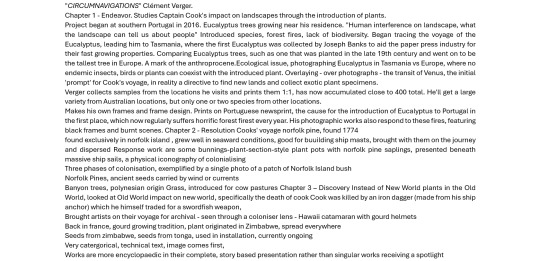
I've been fascinated lately with music that generates itself. My Model:Cycles groovebox comes with a sequencer with a 'chance' function, allowing patterns to generate randomly, turning music into a balance of probability.
Martsman ▶ “Generating algorithmic Jungle music based on the Fibonacci Sequence in Pure Data” https://youtu.be/OwkacnSUn10?feature=shared

I met up with Mike for a one-on-one on Tuesday, bringing my SP-202 along for some extra reference.
Explaining my work idea, along with the growing imperative to construct my own sampler for the piece, Mike instead entertained the possibility of having Ableton - a highly 'able' music software - perform the same function.
From there, I could wire up a custom midi control for the audience to interact with, a task which would still require a bit of electrical handiwork, just significantly less so.
These were the notes I took during our conversation.
Make the system first (using a proxy MIDI), THEN build a single midi button
Feedback loop → Music without human → "Auto-visual feedback system"
Not actually Ableton, it's Max MSP → You can just have Max MSP, there are operators (hardware) that you can assign to it, giving it functionalities → Instead of going through a multi step recording interface
MAX MSP (Ableton) has patches, saves time, good problem solving, design → Node tree
So how do I get a Max MSP license? $9 a month, will need internet connection → Student version → Max for Live or Max MSP?
Will I even need an induction? → All I'm making is a MIDI controller
Computer overheating? Have hatch in back open, computer breathability
Patches available to download: Auto chop? → Auto sequencer?
A single midi button, streamlines audience action
"Generative drum sample" → "How to make a generative drum machine"
Like those talking hamsters
Movement further: start adding knobs and other functionality
Fahsai last year: motion camera, sound variables patched to movement → Made a 'human' that you touched to make sound.
There's facial recognition patches too, you could remove the button and have it make sound from your face
On Wednesday I had a one-on-one with Israel, and talked about my work so far - or lack there of! had a bit of a vent about the amount of time CPRM class had been taking up lately, but it was good to speak my general directive aloud.
Back at home, I forked out the $28 per month subscription for Max MSP... with the standard plan. Indeed there was a student plan that I was eligible for, but the swindlers didn't provide any monthly option for it!

0 notes
Text
213729 Fine Arts Research & Development: Honors ⋆ WEEK 2
Scanning through my ideas sheet, my most confident ideas were:
A series of larger-than-life cardboard figures in 'conversation' with one another. Speakers, mounted inside their heads would projecting fragments of field-recorded speech at each other, giving the illusion of a chattering crowd. Their voices would have been recorded from a public space with a field microphone, with any segments of conversation being spoken again through a means far removed.
Taping a sampler to my forehead and restricting any conversation made to-or-by me to being processed through a sampler. The idea being that my speech would be picked up by the sampler, chopped, and spat back out in rearranged fragments, or likewise, a person talking to me could have their voice recorded in turn, and I'd walk around with their garbled speech emanating from my forehead.

At first, I was pretty set on trying out the 'forehead sampler' idea, as I'd been wanting to get a PO-33 sampler for a hot minute, and this was as good a reason as any to fork over the $200 for one.

Why a PO-33 though? Four reasons.
It was portable, being lightweight and battery powered.
It had a built in microphone.
It also had a built in speaker.
It had 'chop' functionality, where a recorded audio would be divided amongst the buttons.
But then again, this was a very specific performance that I wanted this sampler for - and how much of this art is my own if so much of it relies on what's offered by this consumer product?
Furthermore, while simple for a sampler, I'd more than likely have to guide the audience as to how to record and playback samples with this thing. Unless I created a simplified case using 3D printing - a whole different beast mind you - I'd need something simpler.
The next step was to find other samplers that fit this parameter, along with being light enough to tape to my forehead. There was only one that got close: The Circutmess Synthia, which is a DIY sampler aimed at kids, but sends you an assembly kit.
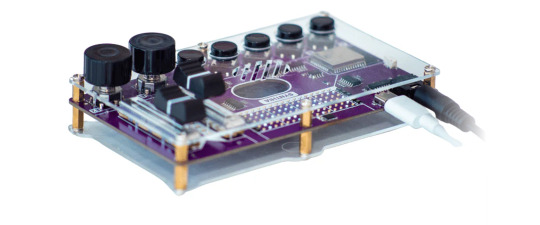
The lack of a chop functionality turned me off, however.
My desire at this point to do a sampling performance piece was dwindling, so I got a better idea - what if I combined my two ideas, and made a sampling sculpture?

Instead of having multiple sculptures automatically conversing, I could have a single sculpture automatically sampling! The audience would still interact with a sampler, speaking into a microphone, with the sculpture speaking back in the way of a mounted speaker.
This would also allow me to fit a larger sound setup within the sculpture, freeing me to use more gear.
I brought the remnants of my 2023 cardboard sculpture, the BRAZEN FUCK OBJECT (and children) into my space for some upcycling.

So what gear would I want? I knew that music software Ableton had some live sampling setups, but I could also have a larger sampler built into the front of the sculpture like a control panel.
The audience would be remixing their own speech with this setup however, and I struggled to find any profundity in the message. If the sampler were hooked up to some kind of sequencer, and any recordings were immediately picked up and spat back out in random segments, it'd breathe a life into the sculpture.
The only problem is that hardware samplers typically don't automatically sample, slice and sequence your recordings without a human touch. I was now getting into a whole new realm of sampling entirely - I had to make my own.

Around this time, Em introduced me to some music students from their CPRM class that were building their own synthesizer. They had been using this chip called a Daisy Seed, running a coding system called Arduino, but this coding setup could also work with a sampler.
Coding AND electronics? I was a long way from my comfort zone, so I looked up some references that I could draw from. This one was getting close to my idea, so I could possibly try borrowing from his schematics.
youtube
Frustratingly, despite noting his project being non-commercial, this guy refuses to share his code or schematics. I had to comb through multiple of his video descriptions to even hear mention of the chips he used, these being the Arduino Mega 2560, the ESP32, and most useful: the ISD1820.

Even with the boundless tutorials online for DIY samplers, along with there being music facilities for soldering, my confidence was through the floor. Where could I even begin?
I reached out to Mike for a chat.


Here's some group notes I took in my CPRM class, where I displayed the audio artwork Mycenae Alpha by Iannis Xenakis.

For our Monday class, Eugene hosted our rōpu workshop with a selection of prompts from all the other classes, allowing us to pick and choose.
I chose to collage, as we'd been instructed on printing some material beforehand.
This would be five artworks related to our study:

Along with five non-artworks:
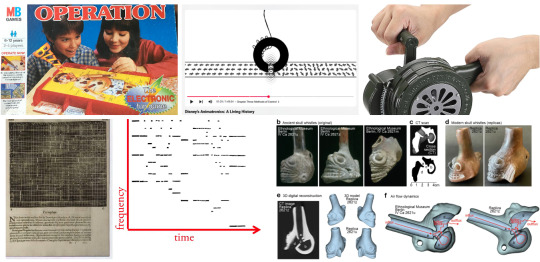
From these, I made three collages determined by a repeated shape:



Two collages "determined by an analogous (...) palette:


And three collages determined by the juxtaposition of narrative elements:
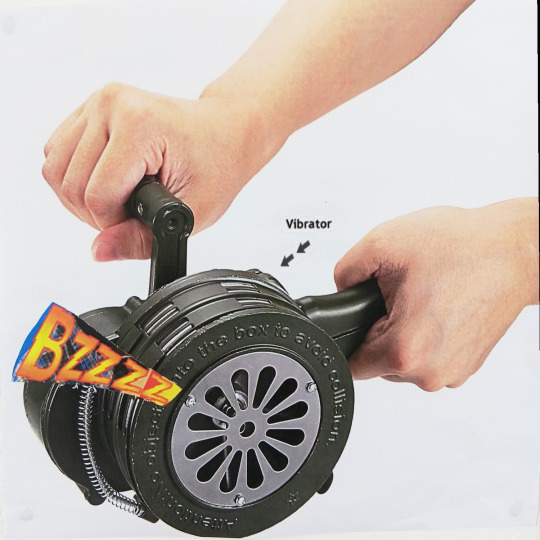
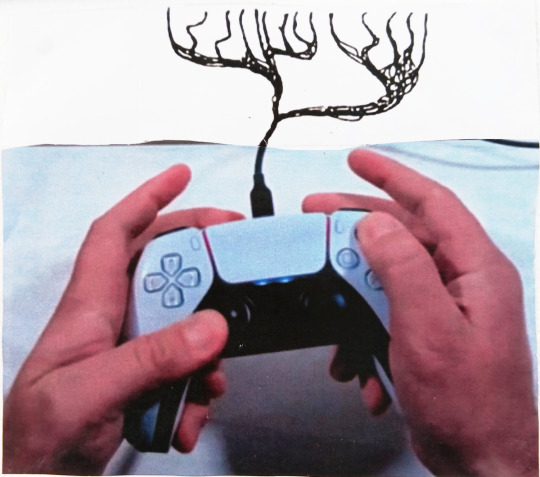

This was a great opportunity to start whittling down all the accumulated sources I'd listed over the holidays, so I reckon I should go a little in-depth about each one and what it represents to my study.
Soundwaves form shapes, but what happens when shape forms sound?
youtube
Mycènes Alpha by Iannis Xenakis is an electroacoustic scan artwork from 1978, running for 9 minutes and 36 seconds.
Utilizing the UPIC (Unité Polyagogique Informatique du CEMAMu), a graphical composition tool developed in 1977 by Xenakis himself, sketches would made upon the specialized tablet using an electromagnetic pen, and read along an X and Y axis, being converted into musical notation as the scan passed from left to right. Mycènes Alpha was Xenakis' first demonstration of UPIC, made up from 10 sheets, which were previously planned out in sketches.
DiNunzio, Alex. ‘UPIC’. Musica Informatica, 25 Aug. 2014, https://www.musicainformatica.it/argomenti/upic.

As the story goes, when Angelo Badalamenti wrote Laura Palmer's Theme for David Lynch's Twin Peaks in 1989, he recorded it all with a single take in 20 minutes, being guided by an eerie description provided by Lynch. Music supervisor Dean Hurley was studying the MIDI notation afterwards, to which he noticed:
“The MIDI notation of ‘Laura Palmer’s Theme,’ you look at it and you’re like, ‘What’s this a picture of?’” Hurley says. “You look at it and it’s actually … Twin Peaks. Fucking eerie.”
“I showed David the photo and I was like, ‘What does this look like to you?’ and he said, ‘Yeah, twin peaks. What about it?’” Hurley says. “And I told him what it was, and he just started shouting, ‘It’s cosmic! It’s cosmic! It’s cosmic!’
Mejia, Paula. ‘This Previously Untold Twin Peaks Story Is Perfectly Eerie’. Vulture, May 2017, https://www.vulture.com/2017/05/twin-peaks-secrets.html.

On the same waveform (ha!) to this, would be the spectrogram for Aphex Twin's ΔMi−1 = −∂Σn=1NDi[n][Σj∈C{i}Fji[n − 1] + Fexti[[n−1]], otherwise shortened to "Formula", where he snuck his face amid the frequencies of the song.
youtube
As a pop musician, Imogen Heap has always been ahead of the curve when it comes to technical influence in her music, and in 2010, she conceptualized what would become MiMU, an expressive glove MIDI controller which allows the musician to control and modulate sound wirelessly, from hand movement alone - further syncing sound and performance.
MiMU is most compatible with the software Ableton. As a Digital Audio Workstation (DAW) Ableton Live is the industry standard when it comes to MIDI connectivity and open-ended sound generation. My initial sketches for my sound sculpture even considered the use of Ableton, as with the building-blocks-like live sound-mixing it offers, I'd be able to run a live sampler off my computer.
@user.friendly.sounds on Instagram is a special example of this, where a Playstation 5 controller is attached to a custom MIDI setup, triggering janky, off-kilter sounds with any combination of buttons.
instagram
The beauty in it is the repurposing of non-musical, let alone non-professional gear towards the creation of sound art, and this is the whole ethos of circuit-bending, a sound making subculture which thrives in re-wiring (or 'bending') the circuit boards of (usually) cheap, toy instruments.
These experiments, often accompanied with the addition of extra knobs, buttons and distortion circuits, create a wildly different sound than would've been intended by the manufacturer.
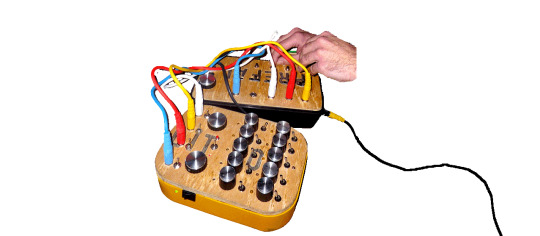
My five non-art references looked at objects designed for sound -eliciting human response. Objects such as the Aztec 'death whistle', which through subtle inner tubing, could replicate an anguished human scream; to the hand-operated siren - produce sounds for the purpose of panic - be it for intimidation or as loud a warning as possible.
The Operation board game is by all means an interactive audio sculpture - representative of form, responding to audience stimulus, and producing sound once a circuit is closed.

Other references looked at the fragmentation of sound into non-sound formats. A lecture on the earliest attempts at sound recording details the various pre-20th century experiments - as far back as the 1200s (!) - of capturing the makings of sound.
Patrick Feaster ▶ “Phonogram Images on Paper, 1250-1950” https://youtu.be/TESkh3hX5oM?feature=shared
Similarly, Kevin Purjerer's excellent documentary on Disney's history with animatronics - specifically culminating in the Lincoln animatronic - mentions how magnetic tape, much the same as on a reel-to-reel, was used to feed code into the machines, in turn producing audio sculptures through analog means.
Defunctland ▶ “Disney's Animatronics: A Living History” [https://youtu.be/jjNca1L6CUk?feature=shared]
In other news, I started making the head for my cardboard sculpture, which is always a riveting experience, because it means I grab a hammer and start ripping the ever-loving shit out of some boxes.



0 notes
Text
213729 Fine Arts Research & Development: Honors ⋆ WEEK 1

Focus
My focus at this point is to continue creating and experimenting with interactive, tactile audio-visual pieces. These are to be reinforced by large sculptural forms that serve conceptual function over decoration. Together, this sound-sculpture blend seeks to immerse the audience into a personal frame of mind as an autistic artist, with works staged to embody experiences of growing up neurodiverse upon the interacting viewer.
Background
What began last year as experiments in sample-based audio developed, through a need for visual reinforcement of the sampling taking place, into interactive, heavily concept-driven works that put the audience in control of the remix. The culmination of this was "Brain", which presented a DJ controller, sitting atop a locked box, connected to a computer within the box - as a stand in for my own brain, which connected to a screen. Following the crudely written instructions painted atop the box to 'play with brain', pressing buttons on the controller would cause snippets of a childhood video of me to play on the screen. This could be endlessly tweaked with the many knobs at the interactor's disposal, essentially allowing the audience to reshape my own memories. I'd whittled down the elements presented in "Brain" to their limits, keeping as few moving parts as could still invite touch, or be anthropomorphized as a post-human spectacle, without the need for further decoration. This move was enthusiastically received by the audience during presentation, and harkened back to the positive response that my garish, spider-like sculptures of the "BRAZEN FUCK OBJECT (and children)" received at the end of 2023. These sculptures, which took a looming, disruptive presence in the room and forced attention in and around their features, were born from a similar, year-long effort to convey a very specific topic to the viewer, which in this case was an accelerating visual culture gone awry. I lean heavily into the hindsight gained from these past showcases this year, where I can recognize, through the power of driving the audience right into the thick of the artwork, the message I wish to express is beamed upon the interacting viewer, their physical, tactile responses embodying the ethos of the piece.
Objective
The trajectory of my work currently melds sculpture, sound and audience interaction. My sculptures, being of sizeable cardboard and duct tape, are familiar to me; the scale of time is known, with the only wildcard being the concept behind it. The sound-based, audience-centric side to this is where experiences are unknown, reactions are unpredictable, and technical 'happy-accidents' are excitingly subject to occur. For me, sculpture will be a reliable medium from which I can amplify the chaotic process that goes into my audio work, a chassis given definition by the sound it projects. Experiment and concept are closely intertwined in the development process. Perhaps I come across some new technology and develop my ideas through it, or perhaps ideas are formed first, then I flip through the practical avenues of bringing it to life, which in turn influence the message it conveys. With the intense physical work that goes into my cardboard sculptures, and the heavy personal interest behind my audio experiments, I put trust in the process that an authentic self comes shining through. This 'self' did not form in a vacuum. I've come around to placing a more personal spin - as opposed to simply personal interest - within my works. This coincides with me growing more comfortable with my identity as an autistic adult, an experience which I am eager to convey through my works this year.
Timeline
Week 1: (done) Setting up workflow, drafting up sketches from holiday notes. Week 2: (done) Week 3: [Finish up writing IPO] Week 4: IPO due Week 5: Crits (Wednesday) Week 6: [Finish the head form; first functional prototype from software] Week 7: Formative Assessment Study Break: [Mainly working on Creative Practice Research Methods] Week 8: [Developing body; custom MIDI controller] Week 9: [Developing body; custom MIDI controller] Week 10: [Developing body; custom MIDI controller] Week 11: Crits (Wednesday) [Finish the full body - self contained and installed] Week 12: Summative Assessment survey
Resources
SCULPTURE:
Cardboard: Free, can be found on the street during recycling night or at the back of cafés.
Duct tape: Typically $5-7 per roll. All three "BRAZEN FUCK OBJECT" sculptures took roughly $100 of tape in total, so a larger sculpture may be up to $200.
AUDIO GEAR:
Speakers: JBL Xtreme 3 Bluetooth speaker with an audio jack. Blown-out KRK Rockit 4 monitor, which I can use for testing. Better options can be borrowed.
Microphone: Cheap, untested XLR; better options can be borrowed.
Instruments: Elektron Model:Cycles, synthesizer/drum machine with MIDI options. Boss SP-202 budget sampler.
Mixing: Wharfedale Pro Connect 802 mixer.
USB interface: Behringer UCA-202.
Misc: DVD/CD drive with USB port. Mounting gear will need to be borrowed. Power supplies easily accessible on campus.
SOFTWARE:
Audacity: Free but limited general audio workspace.
Max: $30/per month subscription. Extremely versatile 'building blocks' for wiring up audio experiments.
References (I'll elborate on these later on)
Disney’s Animatronics: A Living History. Directed by Kevin Perjurer, YouTube Video, Defunctland, 2024, https://www.youtube.com/watch?feature=shared&v=jjNca1L6CUk. Navasquillo Lorda, Eduardo. Remix Theory: The Aesthetics of Sampling. Springer, 2012. https://autoriaemrede.files.wordpress.com/2016/03/remix-theory-eduardo-navas.pdf Feaster, Patrick. Phonogram Images on Paper and the Frontiers of Early Recorded Sound, 1250-1950. https://youtu.be/TESkh3hX5oM?feature=shared. Association for Recorded Sound Collections in Los Angeles. Nikoladze, Koka. People. Video, May 2024, https://youtu.be/7rb-KELFb7U?feature=shared. Reddaway, Richard, and Bryce Galloway. A Late of Zanies. Sculpture, 2021. Glass, Marvin I., et al. Game Utilizing Electric Probe. no. US430395A, US3333846A, 1 Aug. 1967, https://patents.google.com/patent/US3333846A/en.
I really got the ball rolling after I made Brain last year.
The capacities for sound sculpture (in all senses of the word), along with the delightfully cavernous realms of MIDI had me imagining all sorts of avenues I could take things this year, along with a plethora of artists and artworks to draw from. All this I compiled on a single sheet of note paper.

I will be addressing all the ideas and references on this sheet, mark my words.
As I am taking my workings from last year further, there is a lot of context (both technical and concept-wise) that'll need explaining. For that, I'll add some useful snippets from my 2024 workbook, like this:
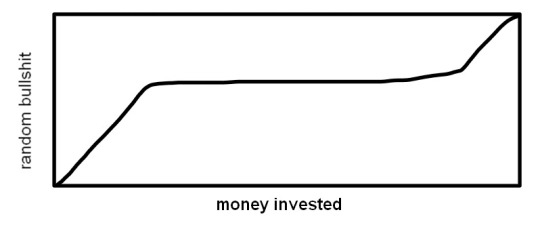
Along with the snippets, several tests and research recordings from the tail end of my 2024 studies blend the line to what I'm looking at this year, and will also be thrown in too, such as:
An experiment using the automatic drawing feature in JSPaint (a browser version of Windows XP Paint) I oversaw last year. Let it run until it crashed.
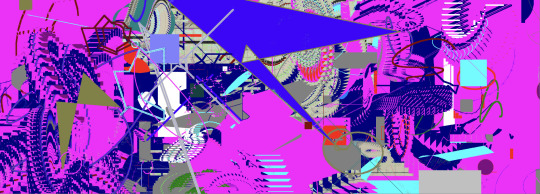
Following the last of our 2024 classes, Em, Olivia, Kiera and I had a conversation about our future projections for art, a portion of which I recorded (the wind gets a little loud at some points).
I own a fair bit of gear now, so let's talk about it.

To begin with, my 1998 Boss SP-202 took up a lot of conversation regarding my work last year. Will I use it as much? Probably not.
I acquired it from Ebay around February 2024, only got around to using it in May, had an electrical issue and nearby burnt the house down, your average stuff. What's important is that this is a sampler, and if a good chunk of my workbook should make any lick of sense, you should probably know what that is.
Take it away, Indio from August last year:
"As a sampler, the SP-202 doesn't make any sounds of its own. Instead, you record sound clips to each of the pads, which in turn play the sound back to you when you press them."
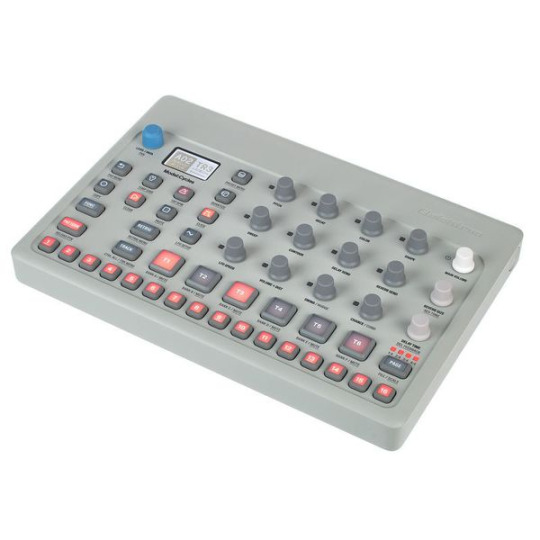
I went into last year getting heart rate spikes when I heard the word "mixing". How the hell did I end up buying my own synthesizer?
It was clear that I'd have to familiarize myself with this side of musicmaking if I wanted to go far with the facets of my sound art. Through the powers of weaponized autism, I simply willed myself to hyperfixate on electronic instruments. At first taking interest in samplers, I soon honed in grooveboxes, which are these all-in-one sequencers that perform the function of a synth, drum machine, and composing workstation!
Several months of research later, I'm now insufferable at functions, but I also brought the Elektron Model: Cycles groovebox for $650 new off eBay. It's an airtight 2020 one-man-band with an FM engine (I will not elaborate) and an incredible skill ceiling!
Where the Model:Cycles gets funky is with the addition of external MIDI control. Simply put, the MIDI can do the walking, and the Cycles can do the talking, and I look forward to having it accompany my experiments this year as a versatile sound module.
But what is MIDI? If you have a sound module (be it a sampler, synthesizer or what-have-you) and want to play sounds from it, chances are you'll be hooking up either a keyboard or a pattern sequencer using MIDI.
When you press a key on your MIDI-compatible controller, a signal is sent out via a MIDI cable, converting this single action into a digital signal of 1's and 0's. The MIDI-compatible module receives this signal, which causes it to play the action assigned to that specific MIDI key.
It is through MIDI that my final piece Brain was possible last year, as each key on the controller was assigned to a different video scene/effect. MIDI will be playing an important role in my works this year.

Over the holidays, I taught myself basic mixing. Making music to any electronic extent is one of big decisions, and expensive mistakes. Hours of comparing price options, consulting forums and asking begrudging music store employees paid off, and I'm wiser for it.
I now own a Wharfedale Pro Connect 802 mixer, which I use for playing sound from my SP-202 and Model:Cycles at the same time (I needed to buy a lot of cables for this).
A Behringer UCA-202 lets me connect my SP-202 to my computer, which makes sampling and recording a breeze.
Lastly, my search for a singular, stereo speaker that doesn't have latency issues led me to the JBL Xtreme 3.
Other miscellaneous items also include a cheap microphone and a DVD drive, which I mainly use for scanning bargain bin CDs.
0 notes